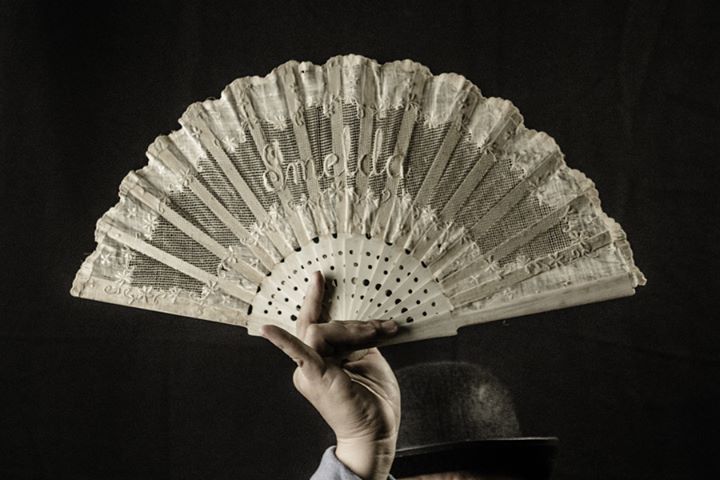UniPro San Diego: What does Community mean to you? - "Your Move"
At the University of San Diego’s Filipino Ugnayan Student Organization (FUSO) 4th Annual Conference, our UniPro San Diego team presented a workshop to encourage and inspire youth and adults to get involved in their own communities. The workshop echoed our conference theme of “Your Move” that was used in four conferences throughout the nation this year [FYLPro Fil-Am Summit, UniPro’s Summit, Epyc Empowerment Conference, FIND Dialogue].
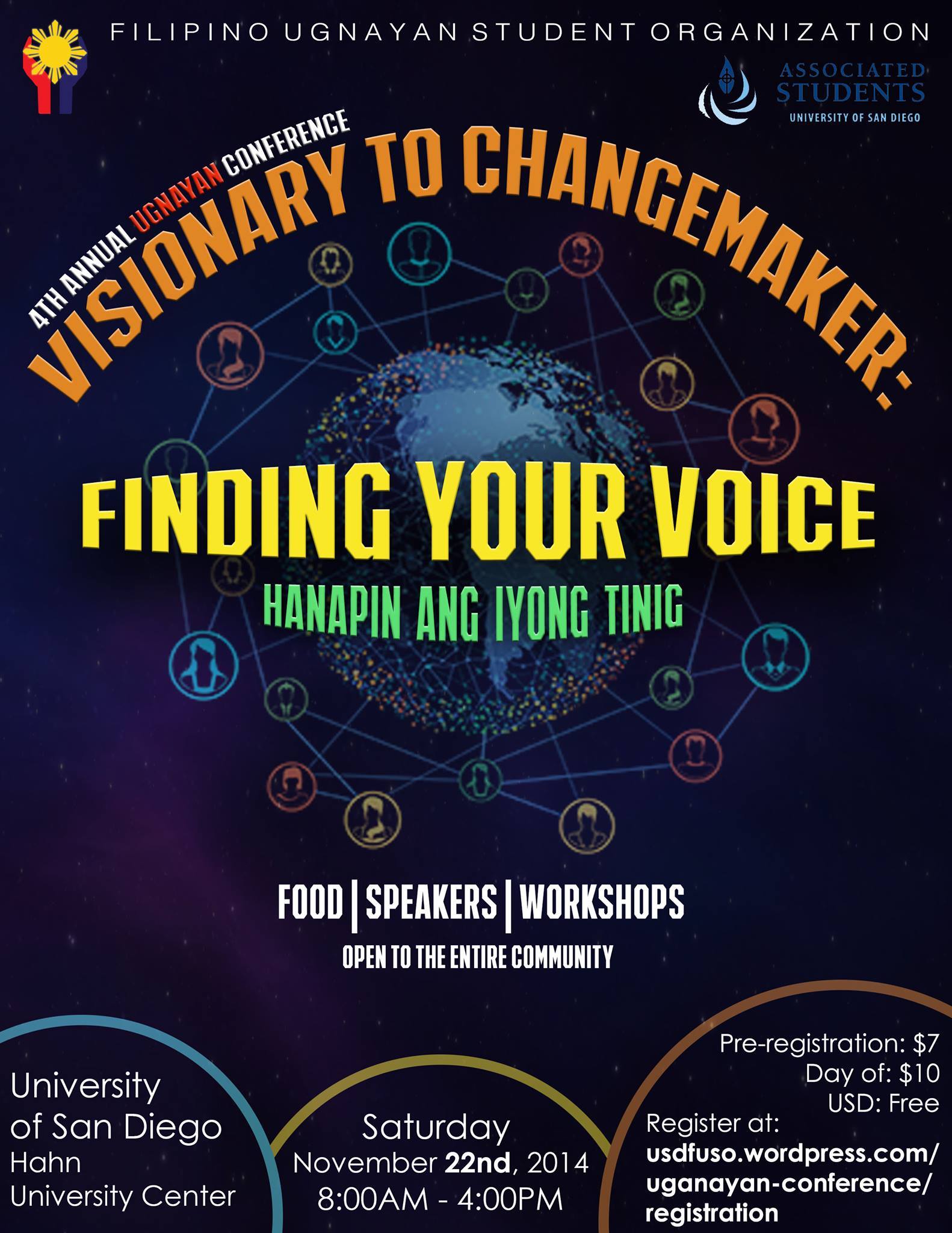
FUSO’s conference theme of “Visionary to Changemaker: Finding Your Voice” parallels the “Your Move” theme by holding the individual responsible and activating them to celebrate and protect human rights. From the FUSO Conference page: “Each member of society brings a unique voice and holds the power to reinvent the present for a better future. In a society silenced by intolerance, it is both our obligation and privilege to combat injustice. We have the vision, now let’s make the change. The Fight Begins Now.”
The I-Gen panel featured a diverse group of speakers from different backgrounds, industries and age groups. Check out their bios at the end of the post.
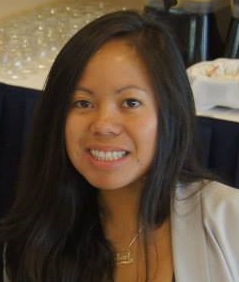
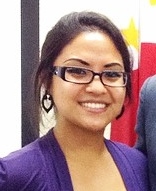
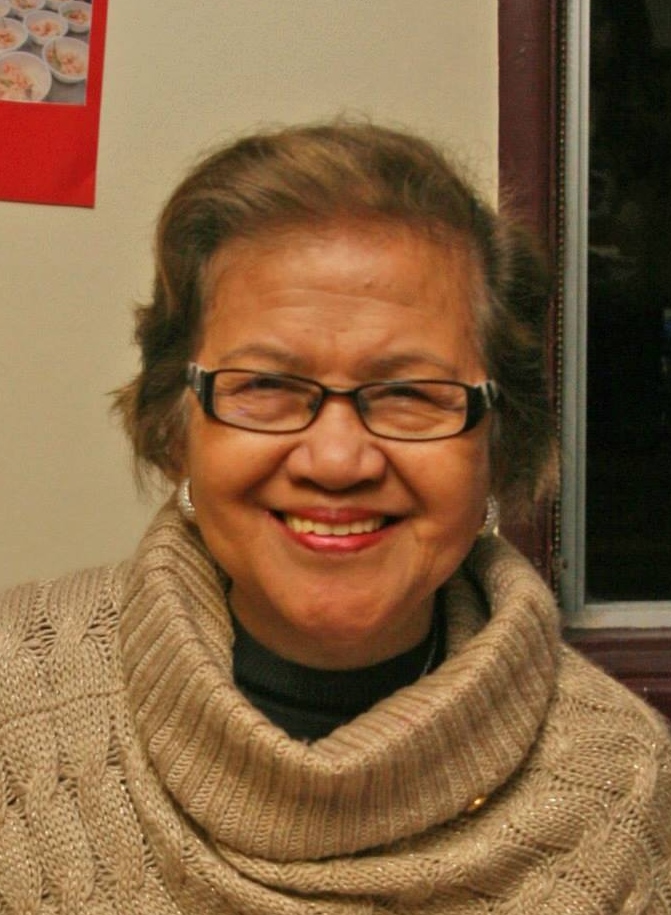
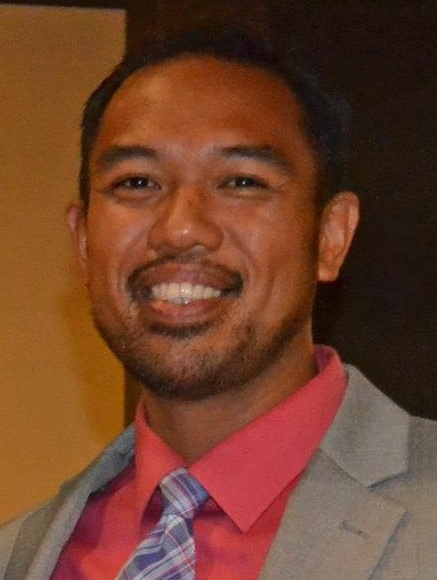
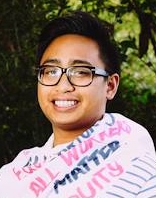
Our panelists from top left to right: Myleen Abuan, Jen Amos, Dr. Aurora Cudal, Ferchil Ramos, Matthew Yagyagan
The panel discussion opened with the questions What does Community mean to you? and What is Community Building? Dr. Aurora Cudal chimed in: “After the discussion on What is Community and Community building, Peter, who attended as an observer told me that I missed to point out that the most important block in community building is the FAMILY. We all come from families and the basic unit is family and our values are nurtured within the family circle. A strong and united community grows out of a strong family with clear and positive family values. As the family grows, a strong community emerges. I asked him, why did you not speak during the open forum? As a newcomer, he has yet to bridge the communication gap. But this guy has so much to offer and yet he prefers to be unobtrusive.”
Comment below and let us know what community means to you!
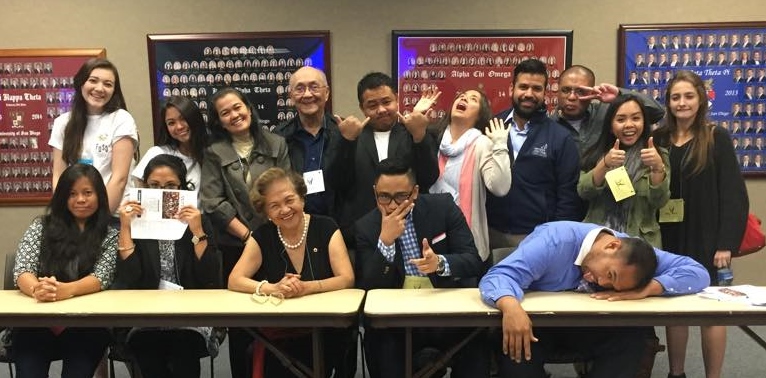
Myleen Abuan is a program coordinator for STRIVE, San Diego! at Operation Samahan. She received her B.S. in Health and Human Services with emphasis in Public Health at San Diego State University. In addition to the work she's done within the Filipino Community, Myleen is also a board member for the Pacific American Education Scholastic Foundation, an organization that seeks to enhance academic opportunities for Pacific Americans through financial and educational assistance programs in support of family and cultural values of the many indigenous natives.
Jen Amos graduated San Diego State University with a degree in Journalism emphasis Public Relations. She is the Founder and CEO of Social Turtles Marketing, a startup company that specializes in social media marketing for small businesses. She also runs a professional blog called The Jen Amos Network that focuses on serving South Bay San Diego entrepreneurs. She lives wholeheartedly by her favorite quote: Happiness is when what you think, what you say, and what you do are in harmony. - Gandhi
Aurora Cudal has occupied various leadership positions in various Filipino American associations, such as Council of Philippine American Organizations (COPAO) of San Diego County, President (1997-98/2004-2005); University of the Philippines Alumni Association of San Diego County, President (2003-2004); San Diego Scripps Lions Club 2005; and Chair of FilAmFest (2006-2008). She is currently a member of the Board of Directors, Foundation for Change; Chair, Public Relations Committee, District 4-L6, Lions Clubs International; and Region 10 Chair, National Federation of Filipino American Associations (NaFFAA). She is a regular columnist and news contributor to The Filipino Press, a weekly newspaper circulated in San Diego County.
Ferchil Ramos, San Diego native, is the assistant festival director for the Filipino American Arts & Culture festival. He hopes to make a difference by connecting and collaborating with communities.
Matthew Yagyagan is the Development Manager of Alliance San Diego. He manages and implements development strategies to raise funds to support the program work of Alliance San Diego. Prior to coming to Alliance San Diego, he was a 2010 OCA Intern in Speaker of the House Nancy Pelosi’s office and was a 2011 Fellow in People For the American Way’s prestigious Front Line Leaders Academy. In his spare time, Mr. Yagyagan is a Mentor with People For the American Way’s Civic Engagement Fellowship and a National Trainer for OCA’s Asian Pacific American Y-Advocate youth leadership program. Mr. Yagyagan graduated early from the University of California, Berkeley in 2010 with dual B.A.s in Political Science and Ethnic Studies.
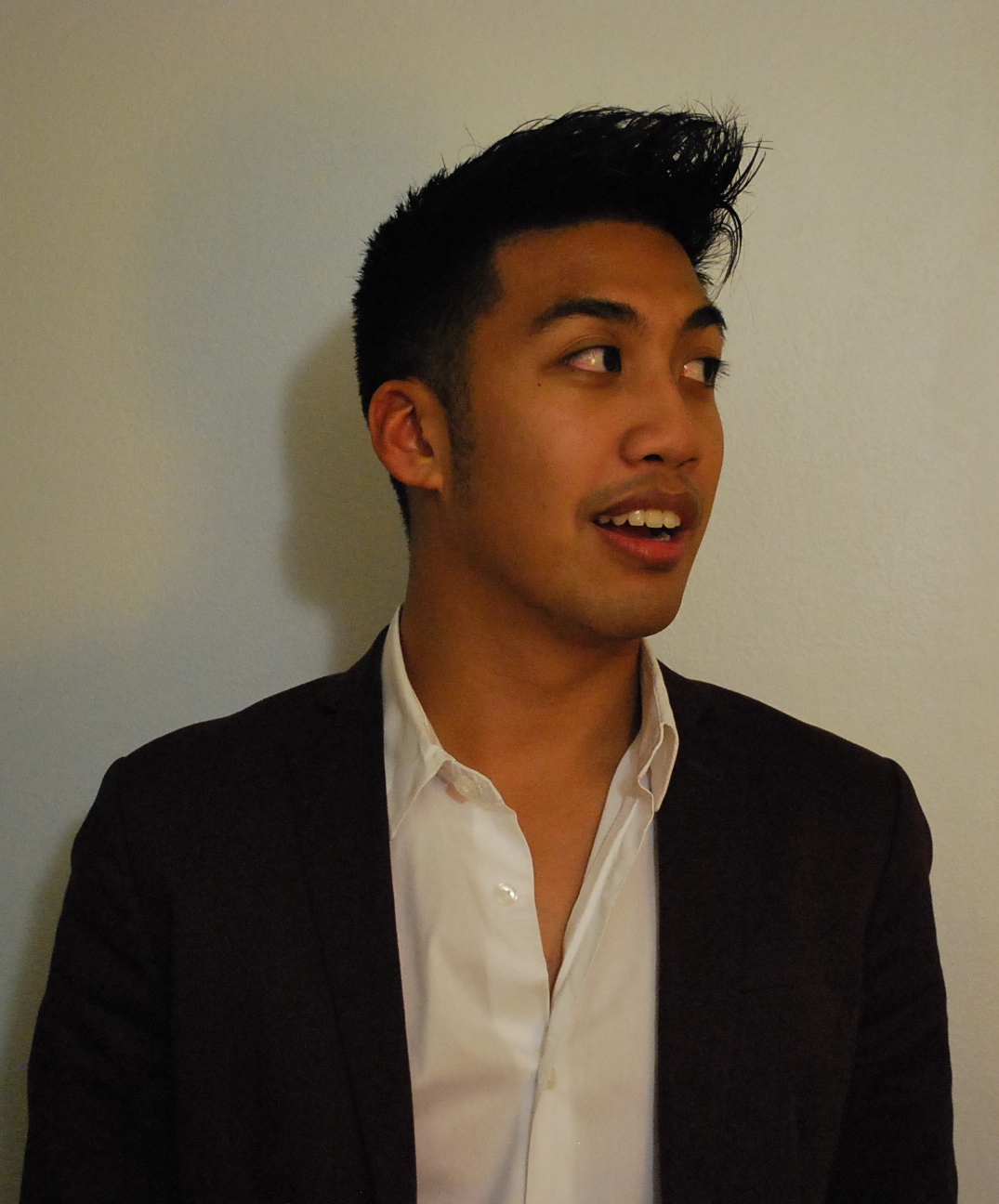 Noel Aglubat is currently the Vice President for Pilipino American Unity for Progress, Inc. (UniPro) and aims make the Filipino-American more visible. He joined Unipro in 2013, has served on the Summit team under Iris and became the Summit 2014 Co-Director. He has a M.S. in Structural Engineering and a B.S. in Civil Engineering from NYU-Poly. Currently he works as a Civil Engineer for the Department of Energy. In his free time Noel loves playing paintball, piano, bass guitar or running up and down the FDR Drive.
Noel Aglubat is currently the Vice President for Pilipino American Unity for Progress, Inc. (UniPro) and aims make the Filipino-American more visible. He joined Unipro in 2013, has served on the Summit team under Iris and became the Summit 2014 Co-Director. He has a M.S. in Structural Engineering and a B.S. in Civil Engineering from NYU-Poly. Currently he works as a Civil Engineer for the Department of Energy. In his free time Noel loves playing paintball, piano, bass guitar or running up and down the FDR Drive.
One Year Later
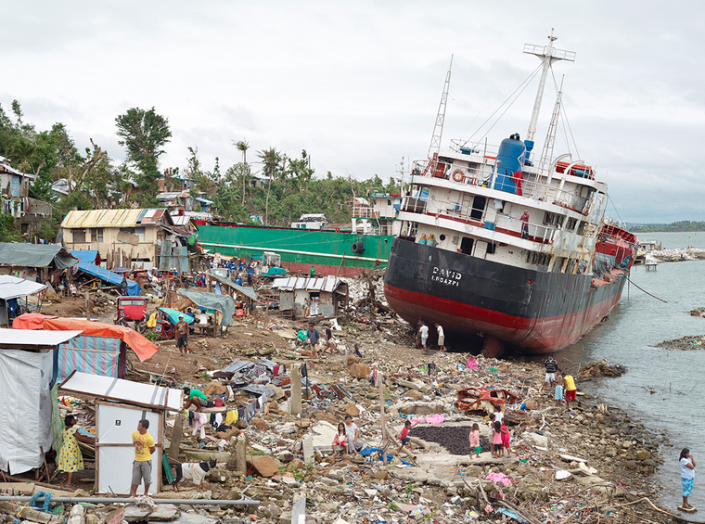 Imagine a super typhoon with a width that spans the entire US Eastern Seaboard. Now, imagine that storm sweeping through a country, causing flooding, landslides and widespread devastation to homes, infrastructure and the agricultural economy. This was a reality for the Philippines on November 8, 2013.
Imagine a super typhoon with a width that spans the entire US Eastern Seaboard. Now, imagine that storm sweeping through a country, causing flooding, landslides and widespread devastation to homes, infrastructure and the agricultural economy. This was a reality for the Philippines on November 8, 2013.
As a Filipina-American, I've been conflicted with how to give back to my homeland. I was born in the States. I've only been to the Philippines a few times - all visits occurred within the past couple of years. How can I possibly be connected to a country that I have never called home? This identity crisis of mine is not unique to my story. In fact, several Fil-Ams grapple with this, including those who may have moved from the PI to the US at a very young age, and identify more closely as an American. So what have I done to give back? I've donated to charitable causes aiding those affected by Typhoon Haiyan (or Typhoon Yolanda). I've supported and advocated for non-profits that are rebuilding in Central Philippines, such as Advancement for Rural Kids (ARK). But among the most helpful for me has been to both read and write about it, and share stories with others. Talking about how the typhoon as affected me has been the first step.
It's been over a year since Haiyan devastated the Philippines. Like other natural disasters - since it's no longer covered by the media - it can be difficult for others around the world to truly understand just how distressed these communities still are. It wasn't until a friend of mine shared a story concerning the aftermath of Haiyan that nearly broke my heart.
In a film by Simon Rawles and Vishva Samani, what started out as a search for survivors evolved into the exposed reality of how mental illness is handled in a country like the Philippines. Due to inadequate healthcare services (also inclusive of mental health services) particularly in impoverished regions, relatives of an individual with a mental illness have very limited options. They are faced with the challenge of protecting their loved one and preventing them from harming themselves or others in the community. However, due to cultural taboos and misunderstandings surrounding mental illness, it is something that is kept hidden. As a result, Typhoon Haiyan uncovered a form of "modern day slavery."
Filmed in northern Cebu, the film sheds light on individuals with mental illnesses who have been chained and caged by their families or loved ones. For example, the film includes the story of a 34-year-old man named Joel Becira, who was put in a cage by his mother after he suffered from a breakdown. It's easy to be frustrated with these images. However, there are several factors that contribute to this reality and one cannot simply place blame on poverty alone. Stigma against mental illness is embedded in Filipino culture and societal structure, and so communities' hands are tied when it comes to caring for an individual living with a mental illness.
The stigma against mental health and mental illness is not unique to the Philippines. It's certainly not unique to the US, as I've shared in previous posts. It's a fear that has been created and maintained by society.
This fear is a social construct that cannot be dismantled by a mere blog post, by an anti-stigma campaign, or by newly implemented laws and policies. It requires us as human beings to acknowledge that those living with mental illness are not untouchables or less than human. We need to care for those around us, and it starts with us talking about mental health and illness in a positive way, whether it's in conversation with friends and family or at work. It starts with us getting trained in Mental Health First Aid, not just First Aid. It starts and continues with us educating ourselves on and advocating for an underserved population that is integral to our society.
The original version of this post appeared on Mama Tanap, a blog that focuses on personal health and wellness.
Taking the Oath: Filipino-American Dual Citizenship
 This past Saturday at the Consulate General of the Philippines in Chicago, eleven Filipino-Americans took the step of making that label official by taking an oath to become full-fledged dual Filipino and American citizens. After being sworn in by Deputy Consul General Romulo Victor M. Israel Jr., the new citizens were welcomed with plates of food (naturally) while some went one room over to claim their official Philippine passports.
This past Saturday at the Consulate General of the Philippines in Chicago, eleven Filipino-Americans took the step of making that label official by taking an oath to become full-fledged dual Filipino and American citizens. After being sworn in by Deputy Consul General Romulo Victor M. Israel Jr., the new citizens were welcomed with plates of food (naturally) while some went one room over to claim their official Philippine passports.
It was a special ceremony held in October specifically in accordance with Filipino-American History Month, but according to Filipino American Young Leaders Program (FYLPro) delegate Louella Cabalona, it’s a “weekly service of the Philippine consulate”. Cabalona; along with Julien Baburka, Abbey Eusebio and Jan Paul Ferrer; make up the Chicago delegates of FYLPro, a program established by the Philippine ambassador to get young Filipino-Americans more interested in the affairs of the Philippine government. “Our association with the consulate is a byproduct of our ambassador’s vision, for us delegates,” says Cabalona.
While the dual citizenship service is readily available, extra effort was put into this special swearing in ceremony. As preparations began, a survey was sent out to gauge interest in the process (which can still be taken here)
Predictably, there are concerns about the drawbacks of becoming a dual-citizen, the most common being about taxes. “I’m not a tax expert,” starts Cabalona, “[but] by the virtue of being Filipino alone will not require you to pay tax to the Philippines”. Of course, there are advantages too. New dual citizen Cheerbelle Guerrero noted that she took the oath because she’s “a Filipino by heart, [and it’s a] good opportunity to show [her] love for the Philippines”. The ability to stay in the Philippines past thirty days without a visa was also a pretty good driving factor. A comprehensive list of the requirements for dual-citizenship, advantages and drawbacks can be found here.
Many Filipino-Americans sworn in saw the value in being able to stay longer in their other home country, or even go to school there or influence high level government via absentee voting. For Cabalona though, the key reason for becoming a dual citizen is much simpler, but comes from a more cosmopolitan point of view. “If you are eligible in becoming a citizen of a country, you should claim our right to be so.” Hopefully this swearing in ceremony will lead to a snowball effect of more people seeking out information, getting their questions answered, and claiming the citizenship that is rightfully theirs.
Post by Ryne Dionisio
 Ryne is a proud Filipino/gamer/geek from the streets of Chicago. His skills include proficiency in HTML, CSS, social networking, Street Fighting, and photographing/critiquing food. He is currently using his powers for good, developing websites for IBM and contributing articles to BakitWhy.com. He is also the host and producer of BakitCast, the official podcast of BakitWhy.
Ryne is a proud Filipino/gamer/geek from the streets of Chicago. His skills include proficiency in HTML, CSS, social networking, Street Fighting, and photographing/critiquing food. He is currently using his powers for good, developing websites for IBM and contributing articles to BakitWhy.com. He is also the host and producer of BakitCast, the official podcast of BakitWhy.
Discover other similar posts on Ryne's blog.
featured image src: clarkisit.com
Kwentuhan Continues: Livin' La Vida Imelda
What is it about Imelda Marcos that has captured the minds of artists lately? Last year, we couldn’t avoid the posters for Here Lies Love, plastered all over New York City; Imelda’s face was thrown back, microphone in hand, the neon sleeves of her Maria Clara gown punctuating the ad for the show at the Public Theater. Word-of-mouth described it as more of a nightclub than a show. It was immersive, a trendy theatrical buzzword, and had music by Fatboy Slim and David Byrne. There were rave reviews, packed houses, and a demand to bring the show back after its initial limited run concluded. For a while, this slice of Filipino history was the hottest ticket in town. But with Imelda Marcos as the twinkling stage diva-du-jour, did Here Lies Love deliver a more glamorized version of her rise to political power than Filipinos recall? This month, we see a new take on the controversial first lady. Livin’ La Vida Imelda, directed by Ralph B. Peña, premiered as part of Ma-Yi Theatre’s current season with creator and star Carlos Celdran at its helm. Mr. Celdran shows a less glorified version of Imelda Marcos than the lovesick heroine of Here Lies Love. Rather than dramatizing her life for the stage, Celdran aims, instead, for complexity.
In fact, the show is based far more in activism, heritage and history, than it is in traditional theatrics. Livin’ La Vida Imelda didn’t start the way most plays start, with workshops or table readings and maybe a small production beneath a proscenium. Instead, it began on the streets of Manila.
Celdran had been leading walking tours of Manila with Walk This Way, a company he founded. A number of routes were offered, which all introduced tourists to major sites around the city. But Celdran’s skills as a performer became the real attraction. Eventually his unique blend of tour guiding, meets musical theater, meets clowning, turned each tour into its own show. His tours became more solidified and scripted. He developed a rhythm and audiences grew.
Livin’ La Vida Imelda began as one of these tours. Celdran led groups past major Marcosian sites in a presentation he referred to as, “ironically irreverent yet informative.” Instead of the disco-dancing woman known outside the Philippines mostly for her shoe collection, Carlos Celdran winded from site to site, stood on the ground Imelda had walked upon and broke down the Marcos mythos. In 2012, The New York Times called the piece, “a delicious mix of history, gossip and social commentary.”
Soon, Ma-Yi Theater’s Executive Director Jorge Ortell took notice of Celdran and had the vision to bring the tour to New York stages.
“I watched the Manila version over two years ago and right away thought this would be very appropriate for NYC,” said Jorge Ortoll, Executive Director of Ma-Yi Theater Company. “I spoke with Carlos, who was willing to make cuts and revise the script to make it more resonant to non-Filipino ears, as our audience is not only Filipino-American, but also non-Filipino Asians and non-Asians.”
How exactly did a walking tour turn into a stage show? Ma-Yi’s expertise paired with Celdran’s vision and storytelling certainly bode well for the future of Livin’ La Vida Imelda and we have high hopes for the production.
As Ortoll explained, “Artistic Director Ralph Peña directs the Ma-Yi version and he and Carlos culled it from a 2.5 hour script to 90 minutes. It's tighter, more cohesive and moves at a very rapid pace. We've also added an actual set, projections and multiple lighting and sound cues, to make it a true theatrical piece.”
That said, the team also has the burden of sharing a darker time in Filipino history with New Yorkers-- folks who likely only know Imelda Marcos from bubblegum subway ads or a thumping Fatboy Slim beat. That responsibility isn’t lost on Celdran or the team at Ma-Yi.
“One has to be at least 40-years-old to remember what the Marcos regime was like,” says Ortoll. “It set the tone for unbridled plunder and disrespect of human rights and freedom of speech. The regimes following Marcos all took his example as license to do the same and even more. How and why this happened is an important history lesson to anyone of any age and any nationality.”
If there is one way to tactfully open eyes, it’s with art. It’s no wonder that Celdran, like so many artists before him, have latched onto performance as his form of activism. By mixing humor, music, drama and storytelling, an audience can be taken on a journey through the Marcos’ highs and lows. And, when done well, everyone lands in the same place when the curtain falls, thinking the same thing, experiencing the same feelings and perhaps ready to take the same steps toward positive change.
So, what does Ma-Yi want audiences to take away?
“A sense of discovery,” Ortoll says. “The script brings forth the noble intents of Imelda, but her narcissism and psychoses did not allow for her good intentions to be realized well. She is a complex woman. Only people who lived through the Marcos era remember how harrowing those years were - and history lessons should not be distorted with lies and truth evasion.”

Though the journey of the show was unique, perhaps it’s fitting that Livin’ La Vida Imelda’s origins were in a literal pilgrimage around Manila. Tourists and residents of the city could march together, and come to conclusions about the controversial Imelda Marcos together. Now, fresh audiences in a new country will take their own steps with the story, Celdran still ready and revving as he encourages you to “walk this way!”
Livin' La Vida Imelda closes this weekend. For tickets, head to Telecharge.com.
--
This post is Part 2 in our Kwentuhan blog series. Kwentuhan is a UniPro initiative that promotes storytelling in the Filipino American community. Read Part 1 here.








